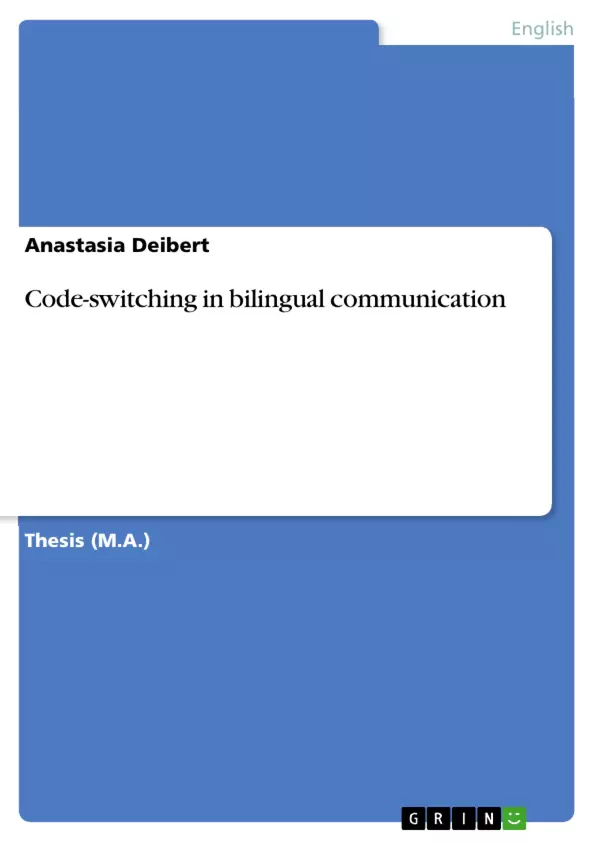This thesis is about the use of two languages in everyday life. Bilingualism is a facet of nearly every country in the world and code-switching is a widespread characteristic of bilingual speech. Today, bilingualism and code-switching research constitute a great area in linguistics. An obvious and at the same time interesting aspect is that bilinguals will, of course, stay within one language when talking to monolinguals. However, when talking to other bilinguals, they will probably use both languages. Thus, in bilingual conversations, they often switch from one language to another and frequently even within an utterance. The following example shows how a code-switched sentence looks like.
(1) Es ist schon interessant как мы так говорим. Я даже не замечаю, dass wir so reden.
It’s really interesting how we’re talking like that. I don’t even notice that we’re talking like that.
Such kinds of switches call for a special competence of the two languages involved. But how well the bilinguals have to know each of the languages is a justifiable question. These switches are not arbitrary since they may depend on the situation of the conversation, the topic of the conversation, the emotional aspects involved, the language preference of the speaker and the need to express the own identity. Bilingualism and especially code-switching were long considered as “a sign of linguistic decay” (Appel & Muysken 1987: 117). It was claimed that bilinguals are not able to acquire two languages properly and language mixing was often considered ungrammatical. However, both negative and positive views on the consequences of bilingualism have been studied and many studies showed positive evidence on bilingualism and code-switching. In recent years, many researchers agreed that code-switching even results from complex bilingual skills and is a natural communicative strategy.[...]
Table of Contents
- Introduction
- Bilingualism and Code-switching
- Introduction to Bilingualism
- Definition
- Who is Bilingual?
- Research Perspectives
- Code-switching
- Introduction
- Definition
- Problems in Defining Code-switching
- Interference
- Borrowing
- Short Research Overview
- Types of Code-switching
- Sociolinguistic and Pragmatic Aspects of Code-switching
- Language Choice, Reasons and Functions
- Attitudes and Feelings
- Theories of Code-switching
- Introduction
- Poplack's Two-Constraint Model
- The Free Morpheme Constraint
- The Equivalence Constraint
- Myers-Scotton's Matrix Language Frame Model
- Defining the Matrix Language and Background
- The Hypotheses of the Matrix Language Frame Model
- Case Study on Russian-German Code-switching
- Introduction
- Historical Background
- Research Method
- Data Collection
- Participants
- Relevant Characteristics of Participating Languages
- Russian
- German
- Analysis of Bilingual Speech Data
- Introduction
- Intra-sentential Code-switching
- Tag-switching
- Inter-sentential Code-switching
- Analysis of Language Situation, Use and Attitudes
- Introduction
- Questionnaire Results
Objectives and Key Themes
This thesis examines the use of code-switching in bilingual communication, aiming to contribute to the understanding of this phenomenon. The study specifically focuses on Russian-German bilinguals. The key themes explored in this thesis are: * **Definition and complexities of code-switching:** The text defines code-switching and explores the challenges in defining it due to overlapping phenomena like interference and borrowing. * **Theories of code-switching:** The work examines two prominent theories: Poplack's Two-Constraint Model and Myers-Scotton's Matrix Language Frame Model. * **Sociolinguistic and pragmatic aspects:** The text analyzes the social and practical factors influencing language choice, reasons for code-switching, and attitudes towards it. * **Case study on Russian-German code-switching:** A detailed case study explores real-world examples of code-switching among Russian-German bilinguals. * **Analysis of bilingual speech data:** The research analyzes different types of code-switching and their linguistic features.Chapter Summaries
* **Introduction:** This chapter provides a general overview of the topic of code-switching and its significance in bilingual communication. The author also shares their personal experiences with bilingualism, highlighting the cultural and identity implications of growing up with two languages. * **Bilingualism and Code-switching:** This chapter defines bilingualism and explores its various aspects. It discusses the different research perspectives on bilingualism, the definition of code-switching, and the challenges in defining it due to issues like interference and borrowing. The chapter also presents a brief overview of research on code-switching and examines the different types of code-switching. Finally, it delves into the sociolinguistic and pragmatic aspects of code-switching, focusing on factors like language choice, reasons for code-switching, and attitudes towards it. * **Theories of Code-switching:** This chapter introduces two central theories of code-switching: Poplack's Two-Constraint Model and Myers-Scotton's Matrix Language Frame Model. It examines the key hypotheses and constraints of each model, providing insights into the rules and principles governing code-switching. * **Case Study on Russian-German Code-switching:** This chapter presents a detailed case study on Russian-German code-switching. It covers the historical background, research methodology, and relevant characteristics of the participating languages. The chapter further analyzes the bilingual speech data, examining different types of code-switching and their features. It also investigates the language situation, use, and attitudes of the bilingual participants.Keywords
This thesis explores the intricate world of bilingual communication, with a focus on the phenomena of code-switching, specifically in the context of Russian-German bilinguals. The core concepts investigated are: bilingualism, code-switching, language choice, sociolinguistic factors, pragmatic functions, interference, borrowing, language attitudes, theoretical models of code-switching, and real-world data analysis.- Citation du texte
- Anastasia Deibert (Auteur), 2010, Code-switching in bilingual communication, Munich, GRIN Verlag, https://www.grin.com/document/266431



